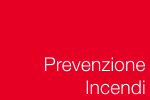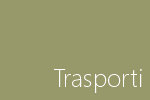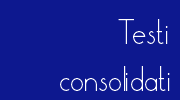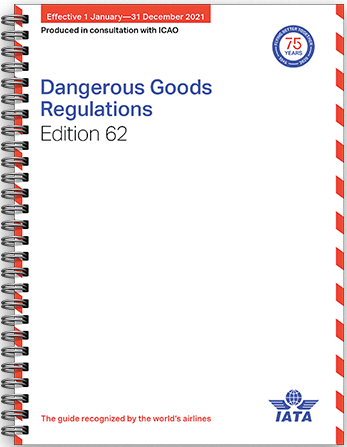Dangerous Goods check list / Documentation 62th IATA DGR 2021
| ID 13173 | | Visite: 15827 | Documenti Merci Pericolose ENTI | Permalink: https://www.certifico.com/id/13173 |
IATA 2021 Manuals Updates (Dangerous Goods Regulations Ed. 62)
ID 13173 | 22.03.2021
Documents related to the 62nd Edition
Significant Changes to the 62nd Edition
Users of the Dangerous Goods Regulations (DGR) are invited to review the Significant Changes to the 62nd Edition
Addendum to the 62nd Edition
- Addendum I Rev 1 to the 62nd Edition (pdf) has been issued and will remain effective until 31 December 2021.
Addendum II to the 62nd Edition
- Addendum II to the 62nd Edition (pdf) has been issued and will remain effective until 31 December 2021.
Checklists for the 62nd Edition
- Non-Radioactive Checklist (pdf)
- Radioactive Checklist (pdf)
- Dry Ice Checklist (pdf)
Batteries, nickel metal hydride (UN 3496)
Infectious substances
Environmentally hazardous substances
Shippers declaration
For the IATA DG Shipper's Declaration (DGD) and e-DGD, please go to the Shipper's declaration page:
DG Shipper's Declaration (DGD) and e-DGD
Satisfying international regulations
To ship dangerous goods, consignors are required to prepare a form certifying that the cargo has been packed, labeled and declared according with the IATA Dangerous Goods Regulations (DGR). The attached sample Shipper's Declarations form reflect those that have been adopted into the 60th edition of the DGR. Forms of the design as shown in the 59th edition may continue to be used until 31 December 2024.
- Download the Dangerous Goods Declaration (DGD)
Electronic Dangerous Goods Shipper's Declaration (e-DGD)
Background
The air cargo industry recognized the need for a digital and paperless process to manage the IATA Dangerous Goods Shipper's Declaration (DGD) among various stakeholders in the air cargo supply chain.
Changes incorporated in 2009 in the ICAO Technical Instructions enable and support the use of electronic data for DGD, which can be shared using, for example, the IATA Cargo XML standard (XSDG) developed for the industry.
e-DGD Concept
The e-DGD is an electronic approach to manage the IATA DGD, leveraging industry initiatives to digitalize data and embrace data sharing platform principles.
Data is made available on the data sharing platform by the data owner and is accessible to whoever requires it depending on the roles and responsibilities in the supply chain. The data sharing platform principle allows for a close collaboration between all stakeholders, including shippers, forwarders, carriers, ground handling agents and third party providers.
In March 2018, the IATA Cargo Services Conference endorsed the principles of data sharing platform for e-DGD with the adoption of a policy item.
Benefits
- Increased data quality
- More transparency and traceability
- Reduced number of errors and delays
- Leaner and faster DG processes
- Improved customer experience
Projects
The IATA e-DGD initiative began at the end of 2016 with the establishment of the e-DGD Proof of Concept (PoC) Focus Group including three airlines and one ground handler (Air France – KLM Cargo, Lufthansa Cargo, Swiss WorldCargo and Cargologic), who had recognized the momentum of the industry to move forward. These actors see the need for the paperless process among various stakeholders in the air cargo supply chain, and are contributing to three non-related DG-community driven projects for the electronic Shipper’s Declaration for Dangerous Goods: e-DGD by Cargo Information Network in France (CIN), e-DG App by IGAC Switzerland in ZRH and InFr8-DGD by DaKoSy / Fraport in FRA.
To facilitate and support these projects, the role of the IATA e-DGD Focus Group is to:
- Ensure that the business processes are aligned among the 3 PoC
- Make sure the XML standard developed (XSDG) is fit for purpose
- Engage with CAA of the pilot trade lanes to verify the acceptance status of electronic data and paper requirement
Download the e-DGD Implementation Guide
___________
Dangerous Goods manuals / Special Cargo manuals / Cargo Operations manuals / Ground Operations manuals
Every year, we update the IATA Manuals in order to stay up-to-date with the latest regulations and best practices. In order to comply with the new regulations and sustain the safe and efficient transport of air cargo, your editions need to be updated annually.
This year was an exceptional year with the pandemic, and it impacted the way air cargo and ground operations operate. For this reason, the new editions of the IATA Manuals now include COVID-19 specific content. The complete list of significant changes for each manual are detailed below.
Dangerous Goods manuals
Dangerous Goods Regulations (DGR)
Complete revision of Subsection 1.5 - Training Requirements to implement competency-based training and assessment for dangerous goods
Revision to the requirements applicable to post items when dry ice is used as a refrigerant for UN 3373
Additions and revisions to the list of dangerous goods
Revisions requirements in special provisions and the addition of new special provisions
Amendments to packing instructions to revise the types of packagings permitted to better align to the UN; clarify the packagings for batteries
Identify that it is mandatory for operator to perform a safety risk assessment to address the carriage of dangerous goods
Implement the changes to section 10 - Radioactive Materials arising from the revision to IAEA SSR-6
Lithium Battery Shipping Guidelines (LBSG)
Revisions to special provisions A88 and A99 to require the approval of the authority of the State of the operator in addition to the authority of the State of origin. These special provisions address the approval for the transport of prototype lithium batteries that have not passed the UN 38.3 tests and approval for the transport of lithium cells or batteries that have a net mass exceeding 35 kg
Special provisions A88 and A99 have also been revised to identify that when lithium batteries are shipped in accordance with an approval that the packing instruction number shown on the Shipper's Declaration must be PI 910 or PI 974, respectively
The format of the lithium battery mark has been revised to now be a square with minimum dimensions of 100 mm x 100 mm. This may be reduced to be not less than 100 mm x 70 mm where the size of the package prevents the application of the full size mark. The wording in the provisions for the application of the mark identifies that mark must be a square or rectangle, which permits the continued usage of the current mark which is 120 mm x 110 mm
Infections Shipping Substances Guidelines (ISSG)
Addition of a new entry and conditions for solid medical waste containing Category A pathogens
Update to identify that the mark in the diamond applied to packages containing biological substances, Category B (UN 3373) and genetically modified organisms and microorganisms (GMO, and GMMO) (UN 3245) must be applied on one side of the package
A change to renumber the packing instruction applicable to medical waste from PI 622 to become PI 621 to align to the number in the UN Model Regulations and to provide for a consistent PI for the new Category A waste. There is a 3-month transition provided during which time the old PI number may be used
Special Cargo manuals
Live Animals Regulations (LAR)
To avoid any confusion and for the sake of consistency, all relevant Container Requirements have been restructured, specifying the feeding and watering requirements into one specific section;
We also amended the section related to the IATA Live Animal Acceptance Checklist with the inclusion of the species and the related container requirement directly on the checklist.
Inclusion of the Center of Excellence for Independent Validators (CEIV) for Live Animals logistics
New Appendix I that contains the CEIV Live Animals checklist and accompanied guidelines
Perishable Cargo Regulations (PCR)
Inclusion of the Center of Excellence for Independent Validators (CEIV) for Perishable Logistics
New Appendix that contains CEIV FRESH audit checklist and guidelines to allow industry benchmark
Temperature Control Regulations (TCR)
The IATA Acceptance Checklist for Time and Temperature Sensitive Healthcare Shipments was modified to avoid any misinterpretation related to shipments delivered on temperature-controlled trucks
Cargo Operations manuals
ULD Regulations (ULDR)
Clarification on the use of TSO certified cargo straps
Updates on some aircraft contour drawings
Deletion of obsolete ULD Type Codes
Operational efficiency improvements
Clarification on bilateral agreements between CAAs
Addition of aircraft pallet components listed on ULD Operational Damage Limits Notice (ODLN)
IATA Cargo Handling Manual (ICHM)
Changes to the wording and definitions of events
Maintaining distance, disinfecting GSE, using drop zones (cargo on ramp) to avoid cross-contamination
Biosafety measures and Poster
Special Handling Code CIC (Cargo In Cabin) and warning about aircraft’s structural limitation change when the cabin is modified
Revision of the wordings used regarding the calibration of scales and the “checks” required
Compassionate Transportation Manual (CTM)
new IATA manual on how to prepare, ship and handle human remains
Ground Operations manuals
Airport Handling Manual (AHM)
Changes as a result of the COVID-19 pandemic:
New: AHM Chapter on Pandemic management
Ground Handling during COVID-19
Transportation of Cargo in Cabin
Chapter 11 - training requirements for Return to Services
New: GSE Storage and Return to Service
Additional changes:
Revisions of AHM 904, 910, and 921 on Ground Support Equipment Specifications
New part of Chapter 9 - Mobile passenger boarding ramps
AHM 600 - Occupational health and safety and aircraft damage cost models revision
AHM 300 - Entirely revised section
Revision of Chapter 4 - AHM 440 on Aircraft Handling and Loading
New graphics and animation for Aircraft Marshalling and Hand Signals
IATA Ground Operations Manual (IGOM)
Changes as a result of the COVID-19 pandemic:
Chapter 3 - Aircraft Cleaning (non-COVID-19 and COVID-19 changes)
Chapter 4 - Aircraft Ground Movement
Ground Handling during COVID-19
Transportation of Cargo in Cabin
Additional changes:
Chapter 1 - Passenger Handling procedures
Chapter 3 - Potable water servicing
New graphics and animation for Aircraft Marshalling and Hand Signals
Collegati
Dangerous Goods Check list / Documentation 60th IATA DGR 2019
Tags: Merci Pericolose IATA











































